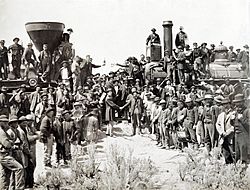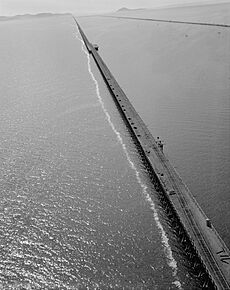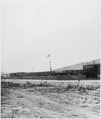Promontory, Utah facts for kids

Location of Promontory, Utah
|
|

Andrew J. Russell's picture recording the meeting of the First transcontinental railroad
|
|
| Overview | |
|---|---|
| Locale | Box Elder County, Utah |
| Dates of operation | May 10, 1869–September 1942 |
| Successor | Lucin Cutoff, January 1905 |
| Technical | |
| Track gauge | 4 ft 8 1⁄2 in (1,435 mm) standard gauge |
| Other | |
| Website | Golden Spike National Historic Site |
Promontory is a special area in Box Elder County, Utah, United States. It is located about 32 miles (51 km) west of Brigham City. This high ground reaches 4,902 feet (1,494 m) above sea level. It sits north of the Promontory Mountains and the Great Salt Lake.
Promontory is famous for Promontory Summit. This is where the First transcontinental railroad was officially finished. The railroad connected Sacramento to Omaha. This historic event happened on May 10, 1869.
People sometimes confuse Promontory Summit with Promontory Point. Promontory Point is further south along the Promontory Mountains. Both places are important to the Overland Route. Promontory Summit was where the original railroad crossed. Promontory Point is where a newer railroad line, called the Lucin Cutoff, crosses today.
By the summer of 1868, the Central Pacific (CP) had built its railway through the Sierra Nevada mountains. They were moving towards the Interior Plains and the Union Pacific (UP) line. More than 4,000 workers helped build this part of the railroad. About two-thirds of these workers were Chinese. They laid over 100 miles (160 km) of track at high altitudes.
In May 1869, the two railroad lines finally met. This meeting happened at Promontory Summit, Utah Territory. A special crew of Chinese and Irish workers laid the last 10 miles (16 km) of track. They did this in just 12 hours, just in time for the big ceremony.
Contents
The Golden Spike Ceremony
Promontory Summit was chosen as the official meeting point for the two railroads. This decision was made in Washington, D.C., in April 1869. It was also decided that a special ceremony would be held. During this event, the famous Last Spike would be driven in. This would mark the completion of the railroad.
The ceremony was first planned for May 8. However, it had to be delayed for two days. Bad weather and a problem with workers on the Union Pacific side caused the delay. Over 400 workers had not been paid. They chained Vice-President Thomas Durant's train car to a side track. They held it there until he sent money to pay them.
After this delay, Durant's train faced another problem. Floodwaters threatened to collapse a bridge in Wyoming. The train's engineer would not cross the shaky bridge. So, the passenger cars were pushed across without the engine. Durant then needed a new way to get to Promontory. Another Union Pacific engine, "119," was sent to pick him up.
Finally, on the morning of May 10, the important people arrived at Promontory Summit. The Golden Spike Ceremony took place. The last iron spike was driven at 12:47 PM.
The trains that carried the railroad officials were special. The Union Pacific train was pulled by No. 119. The Central Pacific train was pulled by No. 60, also called the Jupiter. Neither of these engines was the first choice for the ceremony. Other engines had problems on their way.
On May 10, the Jupiter and 119 locomotives faced each other at Promontory Summit. They were separated by only one railroad tie. Many people attended the event. Estimates range from 500 to 3,000 people. These included government officials, railroad leaders, and workers.
Historians believe that Chinese workers were not shown in the famous official photo due to racism. There was strong anti-Chinese sentiment in the United States at that time. However, Chinese workers were honored by the Central Pacific management. They were eating at a special boarding car when the famous photo was taken. Three of the eight Chinese workers who laid the last rail were special guests. They attended the golden anniversary celebration in Ogden, Utah, in May 1919.

The event at Promontory Summit was called the "wedding of the rails." Reverend John Todd led the ceremony. Four special spikes were gently tapped into holes in a special wooden tie. One was the famous golden spike from Californian David Hewes. Another was a second solid gold spike. A third was a solid silver spike from Nevada. The fourth was an iron spike plated with silver and gold from Arizona Territory.
The original golden 'Hewes' spike was later given to the Leland Stanford Junior University Museum in 1898. The second golden spike and the special wooden tie were lost. Some say they were destroyed in the 1906 San Francisco earthquake and fire.
Stanford University loaned the original 1869 gold spike for a movie. It was used in Union Pacific (1939). A brass prop was used for the hammering scene in the movie. The real golden spike only has marks from a Union Army Officer. He hit it with his sword on the way back to California.
No one tried to fully drive the real golden spikes into the wooden tie. Four holes were drilled to hold them. Stanford and Thomas Durant gently tapped them. Then, the special spikes and tie were removed. A regular pine wood tie and four iron spikes were put in their place. The last iron spike was connected to the Transcontinental Telegraph Line.
Stanford and Durant were supposed to hit this last iron spike with a hammer. The hammer was also wired to the telegraph line. This would send a signal across the country. Stanford missed the spike and hit the tie. Durant missed both the spike and the tie. But the telegraph operator still sent the signal. The message "D-O-N-E!" went out across the nation.
With the railroad finished, travel across the country changed. A trip that once took up to six months now took as little as eight days. This was from New York City to San Francisco, using railroads and ferries.
Promontory Summit marked the completion of the First Transcontinental Railroad. This connected Omaha to Sacramento on May 10, 1869. The Western Pacific finished the last part from Sacramento to San Francisco Bay. This happened on September 6, 1869. Passengers had to cross the Missouri River by boat until a bridge was built in 1872. The first non-stop coast-to-coast railroad was finished in August 1870. This happened at Strasburg, Colorado.
Life at Promontory Summit
Promontory was once home to a town called Promontory City. This town grew during and after the railroad's construction. But by December 1869, shops and tents were being taken down. Traders and merchants moved to other towns. In January 1870, train crews moved to Ogden, Utah. Union Station in Ogden became the main meeting point for the two railroads.
Promontory Station still had a station agent and telegraph operator. It also had a Chinese section gang and a gravel train crew. By June 1870, only about 120 people lived at Promontory Summit. Most were Central Pacific railroad workers. A hotel owner and his family lived there, along with 80 copper sulfate miners.
The Central Pacific railroad soon improved the tracks around Promontory Summit. They changed about 10 miles (16 km) of the original Union Pacific line. This removed some steep hills and sharp turns. They also built a roundhouse and turntable. These were places to store and turn locomotives. They added a freight depot and a locomotive yard. There were also new facilities for workers, like an eating car and housing for the Chinese crew.
In the late 1800s, Promontory Station was used by large ranches. They shipped cattle to stockyards in San Francisco and Chicago. Around 1900, wheat farmers started to change the area. Promontory had a one-room school and a store/post office. It became a main stop for small farms. However, during the droughts of the 1930s, many farmers left. Their lands were combined into larger farms.
The Railroad's Decline at Promontory

Union Pacific engineers first thought about building a direct route across the Great Salt Lake. But it was too expensive and would take too long. So, they chose the route through Promontory. As trains got longer and heavier, they needed more engines. These extra engines helped pull trains up the steep grades and around the winding curves to Promontory Summit.
This changed when the Southern Pacific railroad took over Central Pacific operations in 1885. They built a long wooden trestle bridge across the Great Salt Lake. This bridge connected Ogden and Lucin. It was built between 1902 and 1904. This new route, called the Lucin Cutoff, was 102.9 miles (165.6 km) long. It completely bypassed Promontory Summit.
The last regular passenger train to pass through Promontory station was on September 18, 1904. During the Great Depression, railroad traffic dropped a lot. The Southern Pacific decided to stop using the old line. It was no longer making enough money to operate. On September 8, 1942, a special "unspiking" ceremony was held. This marked the removal of the last rail over Promontory Summit. The old steel rails were used for the war effort in World War II.
In the 1950s, the wooden trestle was replaced. A new concrete and stone causeway was built next to it. Southern Pacific kept the wooden trestle as a backup for many years. But it was not used much after the early 1960s. By the 1980s, the old trestle was falling apart. Starting in 1993, the wood from the trestle was taken apart and removed.
Preserving History

By the early 1950s, people started re-enacting the driving of the last spike at Promontory Summit. This new interest led to efforts to save the historic site. In 1957, local groups successfully got the area recognized by the federal government. The Southern Pacific railroad, which owned the land, agreed to give it to the government.
On July 30, 1965, the law for the Golden Spike National Historic Site was signed. The National Park Service now manages the area.
On May 10, 1979, the 110th anniversary of the "Golden Spike" was celebrated. Two new replica locomotives were built for the event. These were copies of the UP #119 and the Jupiter #60. They were brought together on a specially rebuilt 1.5-mile (2.4 km) section of track. The original Jupiter and No. 119 had been taken apart for scrap metal years earlier. The replicas were built in California using federal money. They were made by studying old photos and similar engines from that time.
The park has a visitor center and an engine house. It is open all year. Visitors can walk trails and take audio driving tours. These show the old cuts made for the railroad. They highlight the hard work needed to build the railway over Promontory Summit. On Saturdays and holidays from May 1 to Labor Day, the two replica locomotives re-enact the "Golden Spike" ceremony.
On May 10, 2019, the 150th anniversary of the railroad's completion was celebrated. The important contributions of the 15,000 Chinese railroad workers were finally recognized. Records of these workers were not well kept. Many thousands are believed to have died building the tracks. They faced dangerous conditions, cutting through cold mountains and hot deserts. Many descendants of the Chinese workers attended the ceremony at Promontory Summit. A traditional Chinese lion dance opened the event. The U.S. Secretary of Transportation, Elaine Chao, honored the Chinese workers.
Images for kids
See also
 In Spanish: Promontory (Utah) para niños
In Spanish: Promontory (Utah) para niños


